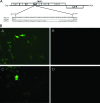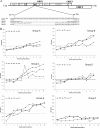Deletions of the hypervariable region (HVR) in open reading frame 1 of hepatitis E virus do not abolish virus infectivity: evidence for attenuation of HVR deletion mutants in vivo
- PMID: 18945785
- PMCID: PMC2612298
- DOI: 10.1128/JVI.01854-08
Deletions of the hypervariable region (HVR) in open reading frame 1 of hepatitis E virus do not abolish virus infectivity: evidence for attenuation of HVR deletion mutants in vivo
Abstract
Hepatitis E virus (HEV) is an important human pathogen, although little is known about its biology and replication. Comparative sequence analysis revealed a hypervariable region (HVR) with extensive sequence variations in open reading frame 1 of HEV. To elucidate the role of the HVR in HEV replication, we first constructed two HVR deletion mutants, hHVRd1 and hHVRd2, with in-frame deletion of amino acids (aa) 711 to 777 and 747 to 761 in the HVR of a genotype 1 human HEV replicon. Evidence of HEV replication was detected in Huh7 cells transfected with RNA transcripts from mutant hHVRd2, as evidenced by expression of enhanced green fluorescent protein. To confirm the in vitro results, we constructed three avian HEV mutants with various HVR deletions: mutants aHVRd1, with deletion of aa 557 to 585 (Delta557-585); aHVRd2 (Delta612-641); and aHVRd3 (Delta557-641). Chickens intrahepatically inoculated with capped RNA transcripts from mutants aHVRd1 and aHVRd2 developed active viral infection, as evidenced by seroconversion, viremia, and fecal virus shedding, although mutant aHVRd3, with complete HVR deletion, was apparently attenuated in chickens. To further verify the results, we constructed four additional HVR deletion mutants using the genotype 3 swine HEV as the backbone. Mutants sHVRd2 (Delta722-781), sHVRd3 (Delta735-765), and sHVRd4 (Delta712-765) were shown to tolerate deletions and were infectious in pigs intrahepatically inoculated with capped RNA transcripts from the mutants, whereas mutant sHVRd1 (Delta712-790), with a nearly complete HVR deletion, exhibited an attenuation phenotype in infected pigs. The data from these studies indicate that deletions in HVR do not abolish HEV infectivity in vitro or in vivo, although evidence for attenuation was observed for HEV mutants with a larger or nearly complete HVR deletion.
Figures




Similar articles
-
Mutational analysis of the hypervariable region of hepatitis e virus reveals its involvement in the efficiency of viral RNA replication.J Virol. 2011 Oct;85(19):10031-40. doi: 10.1128/JVI.00763-11. Epub 2011 Jul 20. J Virol. 2011. PMID: 21775444 Free PMC article.
-
Construction of an infectious cDNA clone of genotype 1 avian hepatitis E virus: characterization of its pathogenicity in broiler breeders and demonstration of its utility in studying the role of the hypervariable region in virus replication.J Gen Virol. 2015 May;96(Pt 5):1015-1026. doi: 10.1099/vir.0.000045. Epub 2015 Jan 15. J Gen Virol. 2015. PMID: 25593160 Free PMC article.
-
Capped RNA transcripts of full-length cDNA clones of swine hepatitis E virus are replication competent when transfected into Huh7 cells and infectious when intrahepatically inoculated into pigs.J Virol. 2005 Feb;79(3):1552-8. doi: 10.1128/JVI.79.3.1552-1558.2005. J Virol. 2005. PMID: 15650181 Free PMC article.
-
Culture systems for hepatitis E virus.J Gastroenterol. 2013 Feb;48(2):147-58. doi: 10.1007/s00535-012-0682-0. Epub 2012 Oct 27. J Gastroenterol. 2013. PMID: 23104469 Free PMC article. Review.
-
Open reading frame 3 protein of hepatitis E virus: Multi-function protein with endless potential.World J Gastroenterol. 2021 May 28;27(20):2458-2473. doi: 10.3748/wjg.v27.i20.2458. World J Gastroenterol. 2021. PMID: 34092969 Free PMC article. Review.
Cited by
-
Zoonotic Hepatitis E Virus: Classification, Animal Reservoirs and Transmission Routes.Viruses. 2016 Oct 3;8(10):270. doi: 10.3390/v8100270. Viruses. 2016. PMID: 27706110 Free PMC article. Review.
-
Evolution of the hepatitis E virus hypervariable region.J Gen Virol. 2012 Nov;93(Pt 11):2408-2418. doi: 10.1099/vir.0.045351-0. Epub 2012 Jul 25. J Gen Virol. 2012. PMID: 22837418 Free PMC article.
-
Molecular Analysis and Modeling of Hepatitis E Virus Helicase and Identification of Novel Inhibitors by Virtual Screening.Biomed Res Int. 2018 Aug 30;2018:5753804. doi: 10.1155/2018/5753804. eCollection 2018. Biomed Res Int. 2018. PMID: 30246023 Free PMC article.
-
Identification of key candidates associated with chronic hepatitis E viral infection.Bioinformation. 2025 Jan 31;21(1):66-77. doi: 10.6026/973206300210066. eCollection 2025. Bioinformation. 2025. PMID: 40255307 Free PMC article.
-
Characterization of the polyproline region of the hepatitis E virus in immunocompromised patients.J Virol. 2014 Oct;88(20):12017-25. doi: 10.1128/JVI.01625-14. Epub 2014 Aug 6. J Virol. 2014. PMID: 25100839 Free PMC article.
References
-
- Aikawa, T., M. Kojima, M. Takahashi, T. Nishizawa, and H. Okamoto. 2002. Identification of indigenous hepatitis E virus from a Japanese patient who contracted sporadic acute hepatitis in 1982. J. Infect. Dis. 1861535-1537. - PubMed
-
- Arankalle, V. A., L. P. Chobe, M. V. Joshi, M. S. Chadha, B. Kundu, and A. M. Walimbe. 2002. Human and swine hepatitis E viruses from Western India belong to different genotypes. J. Hepatol. 36417-425. - PubMed
-
- Billam, P., Z. F. Sun, and X. J. Meng. 2007. Analysis of the complete genomic sequence of an apparently avirulent strain of avian hepatitis E virus (avian HEV) identified major genetic differences compared with the prototype pathogenic strain of avian HEV. J. Gen. Virol. 881538-1544. - PubMed
Publication types
MeSH terms
Substances
Grants and funding
LinkOut - more resources
Full Text Sources
Other Literature Sources

